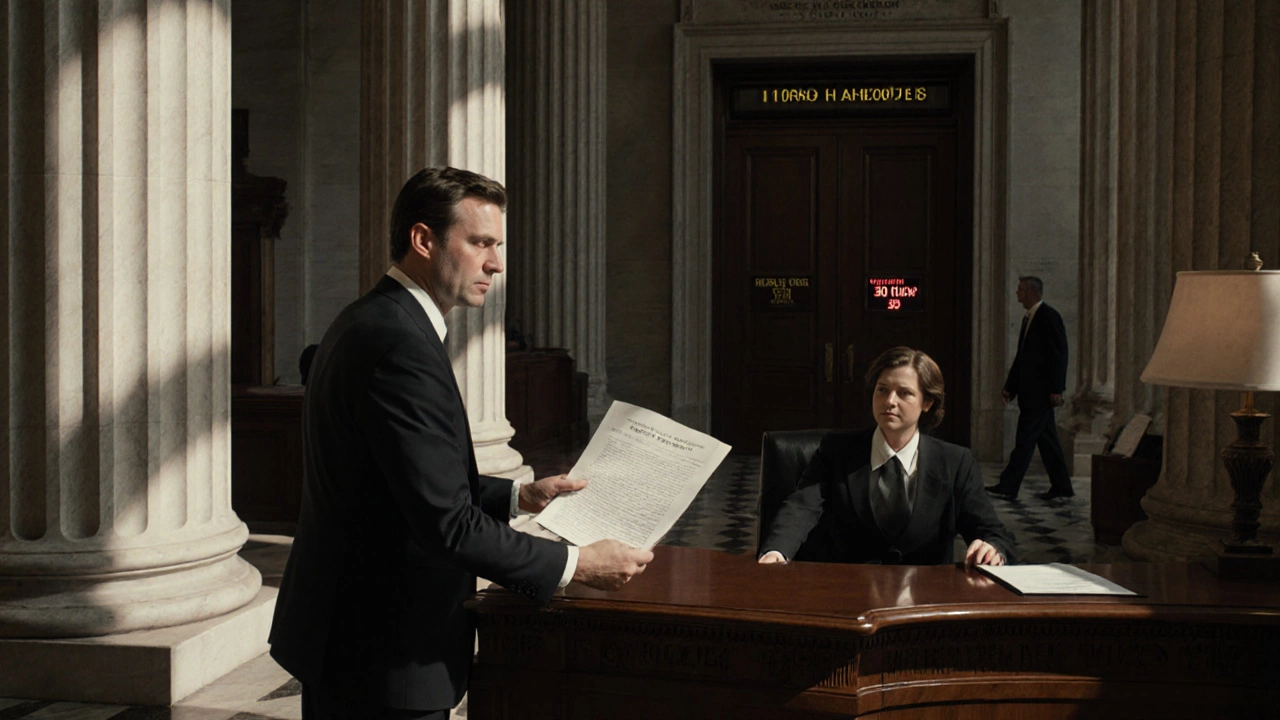Federal Jurisdiction Qualification Checker
Does Your Case Go to Federal Court?
Use this tool to quickly determine if your civil case qualifies for federal court based on key jurisdictional requirements.
Case Details
Results
Enter case details to check qualification.
Quick Takeaways
- Two main pathways send a civil case to federal court: a federal question or diversity of citizenship with a sufficient amount in controversy.
- Federal statutes (e.g., bankruptcy, patents) can create exclusive jurisdiction, forcing a federal forum.
- The "removal" process lets defendants move a state‑court case to federal court, but strict timing and procedural rules apply.
- Even if a case qualifies, parties can sometimes waive federal jurisdiction by agreement.
- A simple checklist can help you decide early whether to expect a federal venue.
Understanding when a civil dispute jumps from a state courtroom to a federal one starts with Federal Jurisdiction is the authority of U.S. federal courts to hear and decide cases that meet specific constitutional or statutory criteria. In practice, two statutory doctrines dominate: Federal Question Jurisdiction and Diversity Jurisdiction. Add a handful of specialized statutes-bankruptcy, patents, securities-and you’ve got the rulebook for when a case “goes federal.” This guide breaks down each pathway, shows you how to run a quick test, and warns about the most common traps.
Federal Question Jurisdiction: The Constitution‑Based Path
Under 28 U.S.C. § 1331, any lawsuit “arising under the Constitution, laws, or treaties of the United States” lands in federal court automatically. The key word is “arising.” Courts ask whether the plaintiff’s cause of action requires interpretation of a federal law as an essential element. If the answer is yes, the case qualifies, regardless of the parties’ residences or the amount at stake.
Typical examples include:
- Claims alleging violation of the Fair Debt Collection Practices Act.
- Disputes over the Americans with Disabilities Act.
- Cases centered on patent infringement, which also enjoy exclusive federal jurisdiction.
When the federal issue is merely peripheral-say, a contract that references a federal regulation but the breach itself is governed by state law-the court will usually deem the case a state‑court matter.
Diversity Jurisdiction: The Citizenship‑And‑Money Test
Diversity jurisdiction lives in 28 U.S.C. § 1332. Two conditions must be satisfied:
- Complete diversity: all plaintiffs must be citizens of different states (or foreign countries) from all defendants.
- Amount in controversy exceeds $75,000 (adjusted for inflation over time).
Both criteria are strict. Even a single plaintiff sharing citizenship with any defendant destroys diversity. The amount‑in‑controversy threshold is measured at the time the complaint is filed; speculative future damages usually don’t count.
Imagine a New Zealand‑based investor sues a California tech startup for $100,000 in breach of contract. Because the parties are from different countries and the claim exceeds the $75,000 floor, a federal court can hear the case.
Exclusive Federal Statutes: When the Law Says “Only Federal Courts”
Some federal statutes confer *exclusive* jurisdiction, meaning state courts are barred altogether. The most common categories are:
- Bankruptcy - 28 U.S.C. § 1334 makes all bankruptcy matters federal.
- Patents - 28 U.S.C. § 1338 grants exclusive jurisdiction over patent infringement.
- Securities - Certain securities‑fraud claims must be filed in federal court under the Securities Exchange Act.
- Federal tax - Disputes involving the Internal Revenue Code often have exclusive federal forums.
When an exclusive statute applies, the case cannot start in a state court. The plaintiff must file directly in a federal district court, and any attempt to remove a state case will be rejected.

Step‑by‑Step Checklist: Is Your Case Likely to Go Federal?
- Identify the legal basis. Does the claim hinge on a federal law, regulation, or constitutional provision? If yes, you have a federal question.
- Check citizenship. List every plaintiff and defendant’s state or country of residence. If any overlap, diversity is dead.
- Calculate the amount. Add up all claimed damages, attorney fees, and interest. If the total is under $75,000, diversity fails.
- Search for exclusive statutes. Look for keywords like “bankruptcy,” “patent,” or “tax” in the complaint. If an exclusive statute applies, federal court is mandatory.
- Consider removal. If the case is already in state court, the defendant can file a notice of removal within 30 days of service, but only if the above tests are met.
- Watch for waivers. Parties can agree to a state forum, or a plaintiff can voluntarily dismiss a federal case and refile in state court if jurisdiction is not exclusive.
Follow this list early in the litigation process to avoid surprise motions and costly venue battles.
Common Pitfalls and Misconceptions
“Any federal law means federal court.” Not true. The law must be *essential* to the claim. Courts use the “well‑pleaded complaint” test: if the federal issue appears on the face of the complaint, jurisdiction exists.
“Partial diversity is enough.” The Supreme Court in *Strawbridge v. Curtiss* (1806) held that *complete* diversity is required-every plaintiff versus every defendant.
“The amount in controversy can be inflated.” Judges will scrutinize inflated figures. Only actual, provable damages count.
“Removal is automatic.” Even if the criteria are met, the plaintiff can file a motion to remand, and the court will examine whether the removal was timely and proper.
After Removal: What Changes in Federal Court?
Once a case is removed, the procedural landscape shifts:
- Federal Rules of Civil Procedure (FRCP) replace state rules.
- The case is assigned to a U.S. District Court, where a single judge typically presides.
- Discovery can become broader, especially under Rule 26(b)(1), which allows “relevant” evidence even if not directly admissible.
- Appeals go to the appropriate U.S. Circuit Court of Appeals and potentially the Supreme Court.
Defendants often prefer federal venues because of perceived neutrality, uniform rules, and, in some circuits, faster timelines.

Comparison Table: Federal vs. State Jurisdiction
| Factor | Federal Court | State Court |
|---|---|---|
| Basis of jurisdiction | Federal question or diversity (plus exclusive statutes) | State law, local statutes, common law claims |
| Citizenship requirement | Complete diversity of parties (if no federal question) | None |
| Amount in controversy | >$75,000 (adjusted) | None |
| Procedural rules | Federal Rules of Civil Procedure | State-specific procedural codes |
| Exclusive jurisdiction | Bankruptcy, patents, certain securities, federal taxes | Generally none (except where federal law delegates authority) |
Next Steps for Litigants
If you’re a plaintiff, start by drafting your complaint with a clear statement of the legal basis. Ask yourself whether the claim leans on a federal statute or if the parties are from different states. If the answer is no, you’re likely staying in state court.
If you’re a defendant, monitor the filing date closely. A timely removal notice can shift the battleground to federal court, but be prepared to defend the jurisdictional basis with affidavits and legal citations.
Consult a qualified attorney early-especially for complex matters like patents or bankruptcy-because jurisdictional missteps can be fatal to a case’s strategy.
Frequently Asked Questions
Can a state court hear a federal question?
Generally no. If a claim is based on federal law, the federal courts have original jurisdiction. State courts may handle the case only when the federal issue is merely incidental.
What happens if the amount in controversy is exactly $75,000?
The threshold is inclusive. A claim of $75,000 satisfies the amount‑in‑controversy requirement for diversity jurisdiction.
Can parties waive federal jurisdiction?
Yes. Through a contractual forum‑selection clause or a stipulation before filing, parties can agree to keep the case in state court, unless the statute provides exclusive federal jurisdiction.
How long do I have to file a removal notice?
Typically 30 days after the defendant is served with the complaint, but the clock stops if the plaintiff amends the complaint to add a new federal claim.
Do all patent cases go to federal court?
Yes. The patent statutes grant exclusive jurisdiction to federal courts, so state courts cannot hear infringement claims.
What is "complete diversity" and why does it matter?
Complete diversity means every plaintiff must be a citizen of a different state (or country) from every defendant. If any two parties share citizenship, the diversity hook fails and the case stays in state court.
Can a case be removed twice?
No. Once a case has been removed to federal court, the plaintiff can only move it back (remand) if jurisdiction is lacking. A second removal is not permitted.
